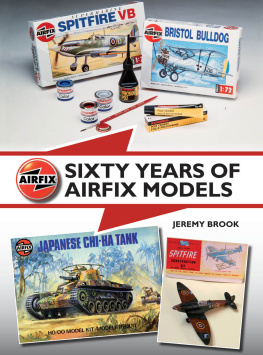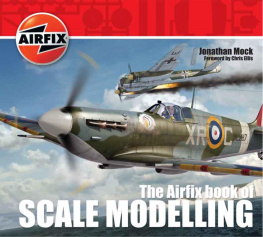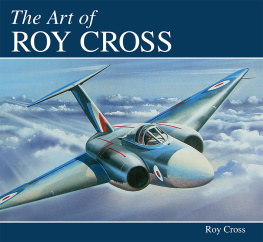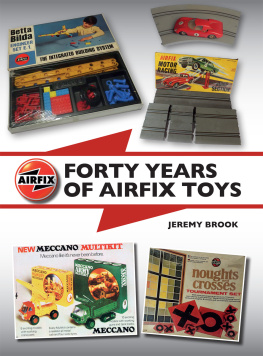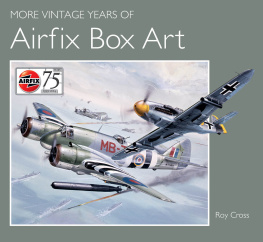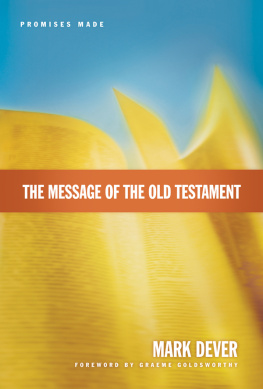
SIXTY YEARS OF
AIRFIX MODELS
JEREMY BROOK

THE CROWOOD PRESS
First published in 2015 by
The Crowood Press Ltd
Ramsbury, Marlborough
Wiltshire SN8 2HR
www.crowood.com
This e-book first published in 2015
Jeremy Brook 2015
All rights reserved. No part of this publication may be reproduced or transmitted in any form or by any means, electronic or mechanical, including photocopy, recording, or any information storage and retrieval system, without permission in writing from the publishers.
British Library Cataloguing-in-Publication Data
A catalogue record for this book is available from the British Library.
ISBN 978 1 84797 976 6
Note: Years given for models and kits in the captions refer to the year in which the item depicted was purchased, which in some cases is not the year of its original release.
Contents

Foreword

Airfix is one of those brands that gets under your skin.
Its hard to know why this is. Lets face it, its only a box full of plastic parts, that by some miracle ends up being the perfect replica of the real thing! And when I say perfect, I mean perfect at any age. At eight years old, that Spitfire with the droopy wings and glue-damaged canopy was the perfect model of one of the worlds greatest ever fighters, and even after taking over the dining table for what seemed like weeks, the whole family agreed too. That is what I believe is the magic of Airfix. Its the fact that it grows up with you, with some creating models that are even better than the real thing well certainly in looks!
If you started Airfix modelling at a young age I think youll know exactly what I mean, if not its never too late to start, and Jeremy, who Ive known for many years, takes you on an informative and enthusiastic tour in the following pages.
Darrell Burge
Glossary

Before the advent of multi-lingual and step-by-step diagrammatic instructions, the early Airfix instruction sheets had an exploded diagram with a written description of each stage. As a child, I learnt many exotic words like nacelle, mizzen mast and pitot tube, to name but a few, all from perusing the kits assembly instructions. The young modeller of today relies on symbols and arrows to help him assemble the kit. Since we are told that a picture paints a thousand words, it means a kit can be made as easily by a child from Sweden as one from Swindon. I cannot help feeling, however, that modern youngsters are losing out on a chance to learn more about the subject they are modelling. Such technical words are outside the scope of this book.
Several unusual words are used in connection with plastic construction kits in this book, and below are simple descriptions of some of the more frequently used ones.
After-market or cottage companies: When a major kit company such as Airfix produces a new kit, there are several small companies out there which produce short-run components for advanced modellers to use to detail their kits or produce new variants. The parts are usually made out of resin or photo-etched metal. They tend to be available for a limited time. Some cottage companies produce whole kits in limited runs or detailed decal sheets for many kits.
Decals: The standard term for the markings on a sheet that are transferred to the painted model. They can be water-slide or peel-off. Older modellers grew up calling them transfers.
Flash: Flash is the very thin plastic that sometimes surrounds a moulded part. It is usually seen on older kits where the mould is beginning to wear and the molten plastic is forced out between the two faces when they are closed together. It is very easily removed but can be difficult on very fine pieces.
K-resin: A harder compound polythene that Airfix has been using on its latest issue of the 1:32 figure sets. The earlier sets were produced in polythene, which whilst meaning the soldiers did not break, were very difficult for paint or glue to adhere to. K-resin is harder and seems to accept paint better, although bayonets are more likely to break off.
Polybagged: Originally many kit companies would swap moulds or lend moulds to another company to mould the kits. However, there is always scope for loss or damage in transit. Nowadays most companies run off a batch of kits, which are then put into polythene bags and sent to another company for them to add decals, boxes and so on. This is known as polybagging. Hornby used several polybag kits when it first took over Airfix to increase the range, but is now using primarily its own moulds.
Polyprop: This refers to the ready-assembled tanks and vehicles that Airfix introduced in its range, aimed more at the younger modeller. They are made of a more flexible polythene compound rather than the harder polystyrene used for standard kits.
Polystyrene: Pre-war and early toys and kits, such as the Ferguson Tractor, were usually made out of acetate, which was unstable and prone to warping. Polystyrene is a hard plastic, which when heated flows easily into cavities in a mould and shows the tiniest of details. Rejected runners can be ground down and used again. It does not seem to scour the mould, so the moulds can last for fifty or more years. Nowadays many early acetate toys have warped quite badly, whereas kits such as the original Golden Hind seem as good as new.
Runner: This is the correct name for the tree or framework on to which all the parts are moulded. The early kits had the parts moulded either side of a straight runner, but later kits had a rectangular runner with the parts moulded inside. This afforded much more protection for the parts, and meant the runners fitted into the boxes better. They are often incorrectly referred to as sprues, and Hornby actually labels its runners as Sprue A, for example.
Sprue: The sprue is the point or gate where the plastic flows from the runner into the individual parts. So when a modeller refers to sprue stretching to produce thin plastic for rigging wires, for example, it should be runner stretching, but it doesnt sound as good!
Transfers: This was the old name, certainly in the UK, for the water-slide transfers that were applied to models. The markings were dipped in warm water, and after a few moments, slid off or transferred to the kit. In the US they were known as decals. Nowadays decal is the word applied to kits, and even full-size aircraft and vehicles use decals.
Vac-form: Most of us are familiar with the plastic trays that are included in food and other containers to keep parts separate. They are made of a thin plastic, which is drawn up into a mould to achieve the shape. It is known as vacuum-forming, as a vacuum is created to pull the plastic into the mould. The plastic sails on the large sailing ships are vac-formed and cut out carefully by the modeller. Many of the military sets, such as the D-Day Assault Sets, contain a vac-form base on which to pose the models. They are, however, very thin and do not react well to being leant on!

